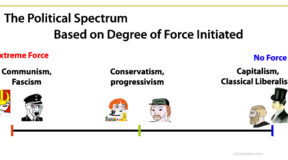
After and during the financial crisis it was widely claimed that the free market had failed. To me this was a bizarre assertion because in order for the free market to fail, we first had to have something at least close to a free market. But a free market in the financial industry did not exist, in fact the financial industry is one of the most regulated and controlled industries in the world. However, the news media suggested that the financial meltdown was caused by deregulation and free markets. In “what market failure?” I showed how the principles of the free market did not fail, but were coercively distorted by government interventions. Parts 1 through 5 explained 5 main government distortions and their grave implications. I encourage to read all the parts for a better understanding of those specific distortions and their effects. But now it’s time for a review.
First, have we been deregulated? The Federal Register, which lists new regulations, annually averaged 72,844 pages between 1977 and 1980. During the Reagan years, the average fell to 54,335. During the Bush I years, they rose to 59,527, to 71,590 during the Clinton years and rose to a record of 75,526 during the Bush II years. Employees in government regulatory agencies grew from 146,139 in 1980 to 238,351 in 2007, a 63 percent increase. In the banking and finance industries, regulatory spending between 1980 and 2007 almost tripled, rising from $725 million to $2.07 billion.
The government’s financial meltdown all started with the idea of affordable housing ownership for the poor. Our representatives decided that instead of going out and starting a construction company that would actually build affordable houses that the poor could actually afford to buy, they would just use the coercive power of the government to achieve their goal. So they passed a law, called Community Reinvestment Act (CRA). This law forced banks to make high-risk loans to people who could not pay them back. The failure to comply meant you get spanked with the government stick, fines, and difficulty in getting approval for mergers and branch expansion. (See Part5). At the same time Fannie Mae, a government-sponsored agency, with its debt being implicitly guaranteed by the federal government, dangled a carrot in front of the banks. They create a credit-scoring formula with a very low qualifying score. They tell banks and other lending institutions, “If you make a home loan to anyone who meets our low qualifying score, we will buy the loan from you at a profit to you.” The lenders play along and make more bad loans. They bite on the carrot. Fannie Mae plays along too and buys the bad loans from the lenders. Fannie Mae creates a portfolio of about $6 trillion (half the mortgage market) in this manner. That’s a lot of carrots! Remember that without their debt being implicitly guaranteed by the federal government, Fannie would not have been able to consistently fund itself. At this point, the mortgage crisis is unavoidable, because this mortgage portfolio that is nominally worth $6 trillion is really worth much less because the people who took out the mortgages will not be able to pay them back. Many of these people would not have gotten a mortgage in a free market. Others would have gotten a smaller mortgage, to buy a home for a much lower price than the price they had to pay; the artificial demand created by Fannie caused home prices to skyrocket.
At this point it seems like the bad loans(rotten carrots) are all confined to Fannie Mae, Fannie Mae is in effect holding the bag of rotten carrots. So how did the rest of the banks end up with these bad loans in their portfolios? As the whole process is going on it’s implicitly known that the government stands behind these risky loans. The reason this is assumed is that for years Government employees have implied, and never denied (except in the fine print of securities prospectuses) that the Government stands behind these risky mortgages. After all, these loans serve the Government’s social goal of affordable housing, surely the Government would not let such a “noble” program fail. Fannie Mae takes these loans and packages them into large bundles. The new bundles are called mortgage-backed securities. The three government-appointed credit rating agencies, Moodys, S&P, and Fitch all slap an investment grade rating on these securities, tripe-A. (See Part4). All the bundles of rotten carrots are now officially triple-A grade investments. Investment firms and banks buy these bundles. Now investment banks are holding some of the rotten carrot bags/bundles. Investment banks create even larger bundles of these mortgages and sell them to regular banks and private firms. Regular banks are required by law to only invest in triple-A rated investments. The banks still trust the government to stand behind these loans, and after all, they are rated triple-A, so there is supposedly very little risk. But, just to be safe, they want some insurance. And so they make a deal with firms such as AIG. AIG sells insurance (called “credit-default swaps”) that promises to reimburse the private firms in case the mortgages go bad. AIG is not worried because, after all, the underlying assets, the mortgages, were created by the Government to carry out noble social policy, if anything goes wrong, surely the Government will stand behind these securities.
So the rotten carrots get passed on from investment banks, back to regular banks, and then to AIG. At this point the whole financial system is eating rotten carrots. It is then realized that these mortgage-backed securities that are rated triple-A are really worthless, they are F’s. A panic in the market starts. Financial institutions take huge losses and their lending capacities are destroyed. Moreover, the government sets the accounting rules to something called market-to-market or fair value accounting. (See Part1). This means that, even if a borrower can pay the mortgage, and if these mortgage-backed securities’ economic value is still decent, the mortgage is down-valued to the current market price of the mortgage. The result is that even more lending capacity is destroyed and the banks call AIG and AIG has to pay up on the insurance it wrote.
At this point, the banks and firms that ate the most carrots are puking the most. Firms that are still afloat are hungry for capital. There are banks and firms in the market that did not eat the carrots. The hungry banks are still able to obtain capital from these healthy firms although at a high price. This all changes on September 25th 2008. One of the biggest carrot munchers, Washington Mutual, goes under. (See Part2). However, the government does not let it go into normal bankruptcy proceedings. The government orchestrates a deal with JPM. JPM acquires Washington Mutual for 1.9 billion dollars. The problem with the deal is that JPM does not acquire any of the debt holders of Washington Mutual. So all the debt holders are wiped out. The people who in normal free market conditions would be the first in line to get something paid back, and really the ones with the rights to make the decisions of what to do with Washington Mutual, will not get anything back for their investment. Healthy firms and banks who were still willing to lend and provide capital close their doors. After all who is going to lend, when the government just sent the message, we can take over any firm and wipe out your investment at any time.
With the market for capital frozen, the government passes the TARP bailout to recapitalize the banks. They force even healthy banks to take the TARP money. There is outrage, the free market has failed, we need to regulate all these banks, even the ones who didn’t want the bailout money. The banks didn’t cause the crisis, didn’t need the TARP until the government literally forced them to take it. These were Mafia-style dealings. The Mafia breaks your store windows in the night, then come in the morning and tell you, we will fix your windows, but from now on you have to pay us a fee to make sure your windows are never broken again. And if you don’t accept their offer, will guess what happens, you find your windows broken again, and probably more.




